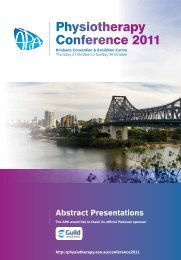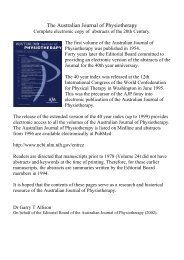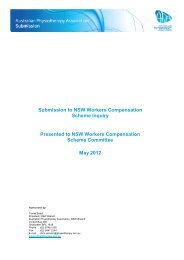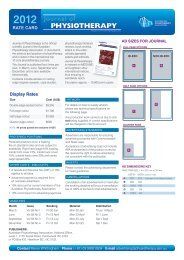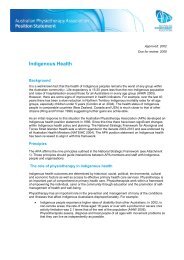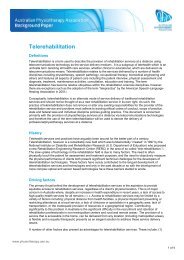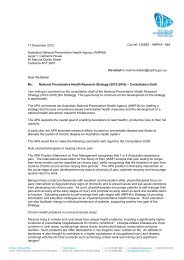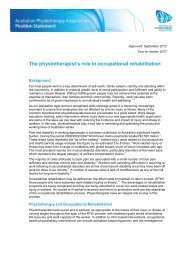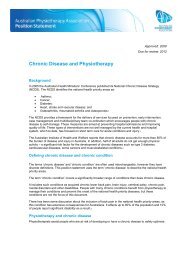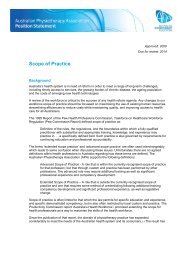The Australian Journal of Physiotherapy
The Australian Journal of Physiotherapy
The Australian Journal of Physiotherapy
You also want an ePaper? Increase the reach of your titles
YUMPU automatically turns print PDFs into web optimized ePapers that Google loves.
<strong>The</strong> purpose <strong>of</strong> this article is to apply the description <strong>of</strong> the role <strong>of</strong> physiotherapy in rehabilitation to<br />
a wider field than has been previously conceptualised. <strong>The</strong> goal <strong>of</strong> rehabilitation is stated to be the<br />
restoration <strong>of</strong> the patient to a self-caring state, or as far as their condition will permit. This article<br />
analyses the role <strong>of</strong> the physiotherapist in accomplishing this goal, addressing the areas <strong>of</strong><br />
personality, qualifications, rehabilitation techniques, evaluation program, types <strong>of</strong> disabilities and<br />
the duties <strong>of</strong> the physiotherapist in team work. <strong>The</strong> author comments on the need to alter training<br />
approaches to allow students to accommodate the new regime.<br />
Keywords: Physical <strong>The</strong>rapy; Rehabilitation; Self Care (Rehabilitation)<br />
Farnbach M (1955): <strong>Physiotherapy</strong> for poliomyelitis patients in Victoria. <strong>Australian</strong> <strong>Journal</strong><br />
<strong>of</strong> <strong>Physiotherapy</strong> 1: 182-187.<br />
This article is a descriptive account <strong>of</strong> the method and organisation <strong>of</strong> physiotherapy intervention in<br />
poliomyelitis patients in Victoria. <strong>Physiotherapy</strong> services are commenced shortly after the onset <strong>of</strong><br />
disease consisting <strong>of</strong> active treatment and rest in splints. When possible patients are sent home to<br />
continue studies or other pursuits alongside treatment. Throughout the rehabilitation process<br />
patients are encouraged to be as independent as possible, and those with residual weakness are<br />
monitored regularly following rehabilitation.<br />
Keywords: Physical <strong>The</strong>rapy; Poliomyelitis; Rehabilitation<br />
McCutcheon A (1955): Progress in care <strong>of</strong> the aged. <strong>Australian</strong> <strong>Journal</strong> <strong>of</strong> <strong>Physiotherapy</strong> 1:<br />
188-192.<br />
<strong>The</strong> status <strong>of</strong> geriatric care in Australia is contrasted to that <strong>of</strong> the United Kingdom, observed by the<br />
author while attending the Third Congress <strong>of</strong> the International Association <strong>of</strong> Gerontology, London<br />
1954. <strong>The</strong> author participated in inspections <strong>of</strong> various rehabilitation centres for the aged as part <strong>of</strong><br />
the Congress, and the observations are recorded according to each facility visited. Care <strong>of</strong> the<br />
elderly is reported to be more advanced in the United Kingdom than Australia, and it is concluded<br />
that much work remains to be done if the standard <strong>of</strong> care in Australia is to be comparable to that<br />
overseas.<br />
Keywords: Aged; Medicine; Physical <strong>The</strong>rapy; Rehabilitation



